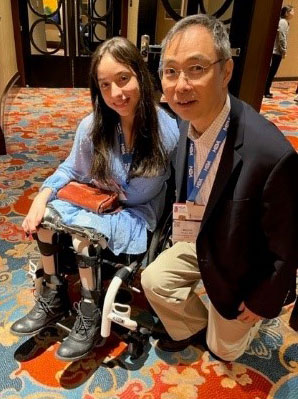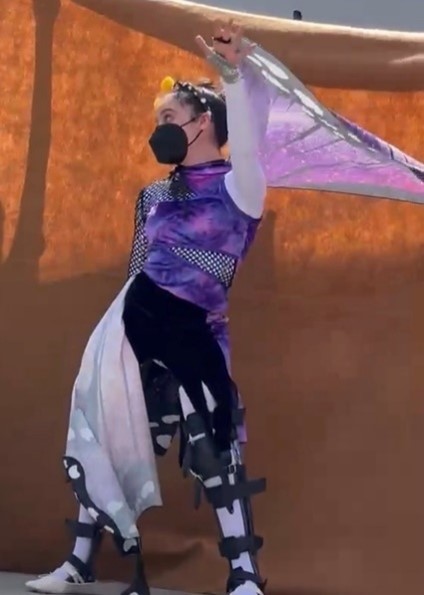Physical activity has countless benefits for everyone, including children with disabilities.
Experts recommend that ALL kids and teens between 6 to 17 years old get at least 60 minutes of moderate to vigorous
physical activity every day. They should also aim to do
activities that strengthen their bones and muscles at least 3 days a week. That frequency, intensity, and amount of exercise can be adjusted to your child's specific needs.
Unfortunately, children and teens with disabilities often face more obstacles when it comes to getting involved with sports and physical activities. That means they don't participate as often. They also aren't as physically fit, overall, and tend to have higher rates of
obesity.
Read on to learn more about why and how to get kids with disabilities involved in physical activity.
Benefits of physical activity
As pediatricians, we encourage children and teens with disabilities to participate in sports, recreation, and physical activities whenever possible. Getting your child involved can boost just about every aspect of their lives.
Some of the many benefits can include:
Better lung capacity and increased muscle strength
Improved physical and cognitive health
Lower body weight
Less isolation and increased feelings of being included
- Better social skills and relationships
Improved mental health and academic achievement
Enhanced well-being and self-esteem
Improved sleep and behavior
Obstacles to physical activity kids with disabilities may face
Physical activity is often at the bottom of the list in a child's treatment plan. This may be because parents and doctors don't always consider all the benefits of exercise, and may be concerned about the risk of injury.
Some of the other obstacles that can make it harder to participate include:
Physical or mental limitations
Low self-esteem
High cost
Lack of accessible facilities or programs
No access to providers who are experienced with adaptive sports for children with disabilities
Bullying by peers or negative stereotypes
How to get your child involved
Kids with disabilities should be offered the chance to participate in sports and other activities that get them moving. There are ways to adapt almost any sport or recreational program. Ask your child what activities they're interested in. Help steer them toward an activity that will help them have fun and do well.
Your child may enjoy activities such as:
Before you sign your child up, talk to your pediatrician about a
preparticipation physical evaluation. You can use this time to talk about any issues that could make it challenging for your child to participate in physical activity. Discuss what options are best for your child and what adaptive equipment they might need.
If needed, your pediatrician will get your child's other care team members involved. Together, they can create physical activity prescriptions. Goals for physical activity can even be a part of your child's
individualized education program (IEP) at school.
If your child needs adaptive equipment
There may be opportunities in your community for your child that you don't know about. Talk to your pediatrician or someone on your child's care team about activities and specialized programs. They may be able to guide you to an activity that would be a great fit for your child.
If the cost of adaptive equipment is an issue, look into grants in your area. Your local Social Services department is a good place to start. You can also check with national organizations like
Move United or
U.S. Paralympics.

Navigating Physical Activity with a Neuromuscular Disease
By: Leah J. Zelaya
 I was born with an ultra-rare neuromuscular disease and was told early on that I would never be able to walk. Through hard work and having confidence in my abilities, I not only started walking using forearm braces, but also have become a dancer, skier, cyclist, actress, and model.
I was born with an ultra-rare neuromuscular disease and was told early on that I would never be able to walk. Through hard work and having confidence in my abilities, I not only started walking using forearm braces, but also have become a dancer, skier, cyclist, actress, and model.
Dance has helped me significantly grow confidence in my abilities. Before I started performing in 2013, there were many times where I wanted to cover up my braces and hide them from the world. After I began dancing, I watched so many talented people with disabilities accept and love themselves, which inspired me to do the same. I love to perform, but I love the support network of inspiring people I have met from dance even more.
 My support network has helped me become involved in physical activity more than I ever could have imagined. From connections I made through dance, I became involved in skiing. Once I tried skiing, I began to be encouraged to try other sports, like cycling and most recently, pickleball.
My support network has helped me become involved in physical activity more than I ever could have imagined. From connections I made through dance, I became involved in skiing. Once I tried skiing, I began to be encouraged to try other sports, like cycling and most recently, pickleball.
A large part of my support network is the
Muscular Dystrophy Association (MDA), an organization I have grown up with. I attend MDA
Camp each summer where I get to meet other individuals with neuromuscular diseases and
volunteers who help run the camps. We play sports, do art and learn from each other. This opportunity helps me stay physically active within my support network. Here, I am motivated to grow, both physically and mentally.
Within the MDA, I am currently a National Ambassador. This platform gives me the opportunity to be a spokesperson for the MDA and travel to Washington, D.C. There, I support equal access to physical activity, treatments for neuromuscular disorders, and most recently,
accessible air travel. I have so many opportunities to be involved in physical activity, and as National Ambassador of the MDA, I get to advocate for others to have these opportunities too.

 My neuromuscular disease is progressive, and recently I have begun experiencing new weakness in my hands. This is a frustrating and scary feeling, but the treatment I receive at the
MDA Care Centers keeps me hopeful. These centers help me and thousands of patients each year by using the latest neuromuscular disease treatments and
gene therapy. I am very grateful for these centers because they continue to allow me to dance, ski, and do all the other activities I love.
My neuromuscular disease is progressive, and recently I have begun experiencing new weakness in my hands. This is a frustrating and scary feeling, but the treatment I receive at the
MDA Care Centers keeps me hopeful. These centers help me and thousands of patients each year by using the latest neuromuscular disease treatments and
gene therapy. I am very grateful for these centers because they continue to allow me to dance, ski, and do all the other activities I love.
Life with a neuromuscular disease means that physical activity plays a key role in my strength, both physically and mentally. From this, I have learned to always pursue what I love while being open-minded, and I encourage other kids and teens to do the same. Physical activity helps me grow my confidence while also helping my body and mind.
I am grateful for my family and support system when trying new physical activities. They constantly remind me of a very important lesson: Focus on what I
can do, not what I cannot.
Leah J. Zalaya is the 2023 National Ambassador for the Muscular Dystrophy Association. In addition to her involvement in dance, sports and advocacy, she has appeared in the film Marry Me, starring Jennifer Lopez and Owen Wilson, and walked in New York Fashion Week. Follow her on
Instagram at leahj.zelaya.
Images, from top to bottom: Leah at an MDA Clinical & Scientific Conference with Michio Hirano, MD, Co-Director of the CUMC Muscular Dystrophy Association clinic; on an adaptive bike, and performing onstage.
Remember
Talk with your pediatrician about physical activity, sports, and recreation options that would meet your child's needs.
More information